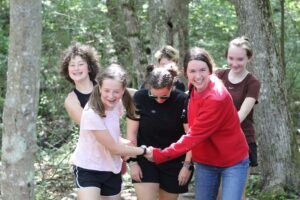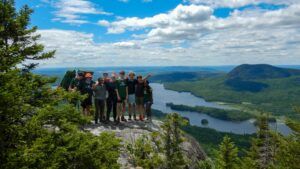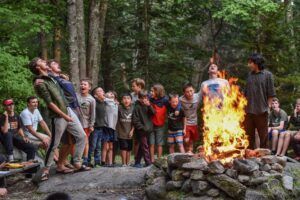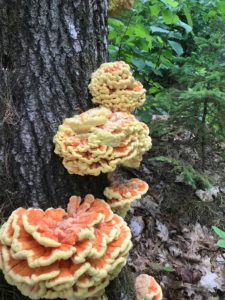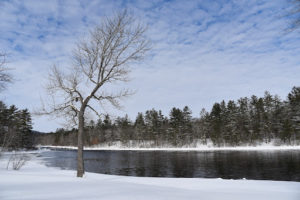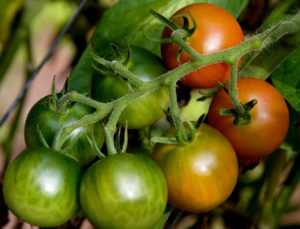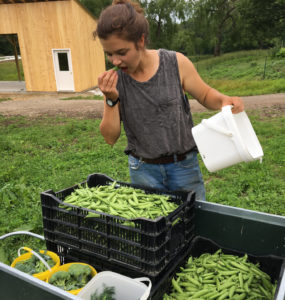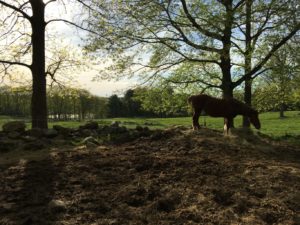Chewonki has lost a legend: Byron, a barred owl (Strix varia) whose dignity, serenity, and beauty held the attention of approximately 80,000 Traveling Natural History Program participants over the course of her lifetime, died on January 6. A long life for a barred owl in captivity is generally about 23 years; Byron was 27.
In 1990, during her first year, someone, for reasons unknown, shot Byron in the right wing. The story might have ended there but somebody else found the wounded owl and delivered it to Brunswick veterinarian Amy Wood. The wing was irretrievably damaged. Wood knew the bird might not survive amputation and if it did, it would never fly again; but it would almost certainly die without amputation.
Wood took off the wing. After the operation, the owl was delivered to Chewonki to recuperate in an aviary alongside other non-releasable (due to permanent incapacitations of one kind or another) wild animals that the Traveling Natural History Program staff care for and integrate into educational programs. She had already acquired the name Lord Byron from a passing reference someone made to the English Romantic poet who wrote, “There is a pleasure in the pathless woods, There is a rapture on the lonely shore, There is society where none intrudes, By the deep Sea, and music in its roar: I love not Man the less, but Nature more…” When it became clear the owl was female, Lord was dropped. Byron stuck.
“I remember Byron’s arrival at Chewonki,” former Chewonki naturalist Lynne Flaccus recalls. “We opened the box and looked down into those dark, beautiful eyes and bright yellow beak and she didn’t make a peep. No bill clapping, no defensive behaviors. She just stepped up onto a glove and looked around. We were all amazed…Tough little nugget she was!”
The owl recovered, then thrived. Staff found her easy to work with and self-possessed in front of crowds. She became a star, accompanying Chewonki educators all over Maine and beyond as they presented natural history lessons in schools, libraries, veterans’ homes, elder housing — wherever there was a request for owl education. Over the past four years, she appeared in front of an average of 153 audiences every year.
“Her personality was majestic, really mellow,” says Emma Balazs, program coordinator. “She was a favorite of all of us because of that extraordinary personality and her tolerance for any situation…She fostered a deep connection.”

Fellow educator Jessica Woodend noticed that connection too. “She had a way of causing an emotional reaction in people who met her,” says Woodend. “I think people responded so well because of her calm and peaceful demeanor…At times of stress, I would go visit Byron in the hope that her calmness was contagious. Knowing her changed me, and while I was teaching others about her, I was learning from her every day.”
“She was one of the sweetest, gentlest animals I’ve ever known,” adds Siobhan Prout, another member of the Chewonki staff. “She spent 27 years as an ambassador for her species and Chewonki and inspired tens of thousands of students and adults to appreciate the beauty, strength, and resilience of the natural world.”
She was the owl of choice for training new Traveling Natural History Program staff, patiently putting up with dozens of young educators slowly learning to work with live animals. Educator Matt Weeks remembers “her tolerance of our slower and more cautious movements as we learned…We try not to anthropomorphize too much, but I always thought of Byron as the kind, patient elder helping to show us the ropes. She helped me become more patient and kind with students learning something new.”
Byron modeled in Maine Coast Semester art teacher Sue West’s drawing classes for many years. Laila Brady, a student in the 5-6 class at the Elementary School at Chewonki, recently made an illustrated book about the owl’s life. Countless Chewonki campers and Outdoor Classroom students got to know her. In short, she was a Chewonki celebrity.
Balazs notes that “After overcoming her difficult beginning, she inspired students of every age to learn about and care for the natural world. It’s an amazing thing.” There are two other barred owls living at Chewonki and they will take Byron’s place in programs, but a generation of Mainers will not forget Byron.
The Cornell Lab of Ornithology website describes the barred owl as an “attractive owl with soulful brown eyes and brown-and-white-striped plumage, [that] can…pass completely unnoticed as it flies noiselessly through the dense canopy…” Early on, Byron lost her ability to fly. As a teacher, she soared.
(Editor’s note: Under today’s laws, birds with injuries requiring amputation of a wing at the elbow or above are euthanized.)




